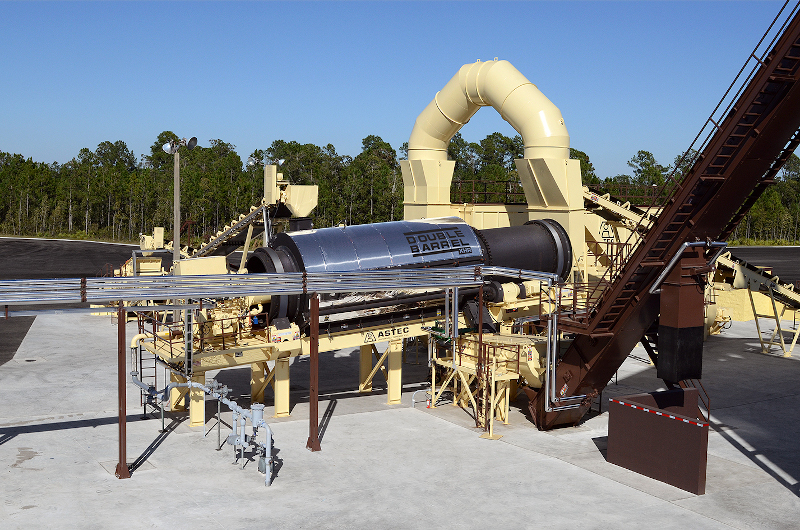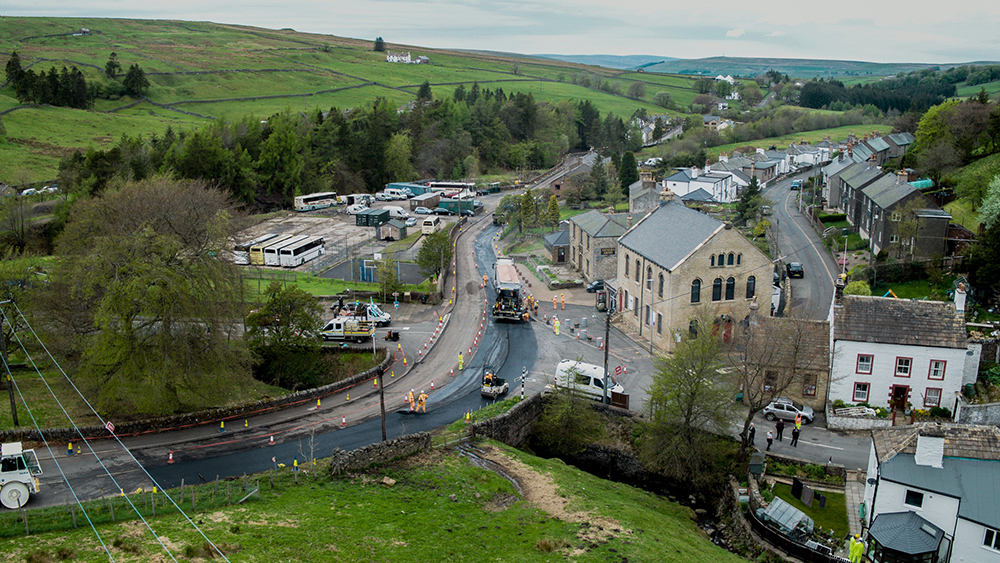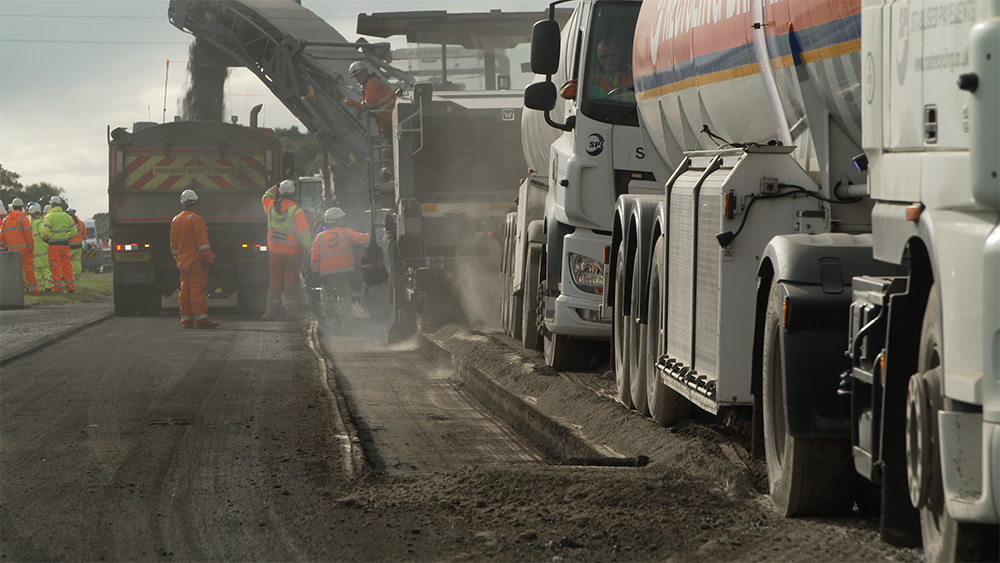User expectations of roads and their surfacing are changing. The next generation of bituminous surfacing will have to meet increasing demands in terms of ride quality, safety and sustainability.
It is encouraging to see the continued transition of our economy from a linear model (take, make, use, dispose) to a circular model (make, use, reuse, remake, recycle). The asphalt industry has a great story to tell in this respect.
Asphalt is 100% reusable and we are well on our way to achieving the goal of a truly circular economy in the sector, but more remains to be done to improve the sustainability of road surfacing. Apart from the increased emphasis on sustainability, road surfacing technology will also have to adopt to changes in transportation technology.
The next decade is expected to bring an unprecedented change in mobility. The introduction of electric and autonomous vehicles will alter the demands placed on the long-term investment that is road infrastructure. Autonomous vehicle-to-infrastructure-communication will put new requirements on road marking and surfacing reliability. The advent of driverless trucks, for example, may lead to a narrower distribution of wheel paths and therefore loading on road surfacing.
In addition, vehicle ownership patterns may change, as fewer people will feel the need to own a vehicle when they can order one from a pool at the touch of a button. What’s more, the income from fuel levies and vehicle registration may decrease, impacting road maintenance budgets, which are already tight in many parts of the world.
Nonetheless, with roads increasingly being viewed as a service, comfort, safety and functionality are considered standard.
When it comes to improving the sustainability of our asphalt pavement, the waste hierarchy is a great tool to guide the decision-making process in selecting the most sustainable solutions. The hierarchy includes the three R’s - Reduce, Reuse and Recycle. Reduction of waste is the most favoured option while the least favoured is recycling materials to a lower value application.
Reduce
Major strides in terms of reduction of waste in road construction have come with the introduction of long-life, or perpetual, pavements; a concept favoured in the US and Europe in the early 2000s. The foundation and base layers of pavements are designed to carry an indeterminate number of heavy vehicles. In contrast to conventional approaches where pavements are designed for failure to start deep in the pavement, perpetual pavements are designed so traffic-induced damage occurs only at the pavement surface. All that is required is timely maintenance on the sacrificial surface layer. Building perpetual pavements negates the need for deep repairs and full pavement reconstruction, which saves on material and, importantly, greatly reduces road closures and user delays, as resurfacing takes less time than deep repairs.
Another strategy to reduce waste from road construction, is to apply purposely designed high-performance asphalt mixes and polymers. This extending the life of the surface and reduces the need for virgin material.
Finally, there is surface preservation treatments where a thin film of bituminous binder is sprayed on an existing road surface to extend the life of the material. This also a sound approach to increasing sustainability. Exposed to sunlight and oxygen, bitumen surfacing oxidises with time, leading to top down surface cracking and stone loss. Surface preservation treatments arrest this oxidation by shielding it from the environment. As a maintenance approach, surface preservation is much underused. This is despite many case studies demonstrating its effectiveness for saving money and quantity of material.
When the time comes to replace asphalt surfacing, the material is milled out and, with the addition of some virgin bitumen or rejuvenator, can be fully reused in a new asphalt mix. From a circular economy perspective, the industry is uniquely placed: all material produced can be reused continuously as asphalt in both surface and base courses. In accordance with the waste hierarchy principles, the reuse of reclaimed asphalt in new asphalt should be promoted. Meanwhile, the recycling of asphalt into lower value applications, such as granular base course or shoulders, should be avoided.
Recycle
Lastly, the asphalt industry has a track-record spanning decades of recycling waste from other industries. Examples include fly ash, steel slag, post-consumer glass and, more recently, plastics. Crumb rubber made from end-of-life tyres is used on a large scale as an elastomeric modifier for bitumen. In countries like the US, Australia and South Africa, crumb rubber modified bitumen has successfully created more crack resistant asphalt and sprayed seals. The use of crumb rubber modified bitumen is an example of a very beneficial application of a problematic waste material and a potential solution for the large stockpiles of tyres building up around the world. It is no surprise that there is a renewed interest in crumb rubber modified bitumen in Europe.
When introducing recycled materials to asphalt, it is critical that it is for the right reasons and without negatively affecting the lifecycle of the product. As an industry, it is essential to guard against the introduction of materials that adversely affect occupational health and safety – such as through emissions - our ability to use the material repeatedly or the technical performance of the asphalt. Incorporating waste in asphalt makes for good media, but if it decreases the performance of the material, it likely won’t be truly sustainable.
Meeting society’s changing expectations of road infrastructure will require innovative surfacing solutions. Change however, is typically slow and incremental in the construction sector, due in part to the high levels of regulation and standardisation. The perceived risk of experimenting with new products, which have uncertain long-term performance, leads to conservative design approaches. This is understandable; under conventional contracts the performance risk is transferred to the road owner immediately upon completion of the road works. The owner is then stuck with the maintenance bill if the surface fails to perform as intended.
However, alternative forms of contracts, such as performance contracts, are increasingly applied to improve the environment for innovation. Under this type of agreement, the contractor is responsible for the performance of the product for a defined period of time. The period may be relatively short, such as two years, or as long as 20. The result is that the risk of innovation, and the possible reward, lies with the party best positioned to manage this risk - the contractor. In this respect, because of the possible returns in prolonging the resurfacing cycle, contractors and their suppliers will select materials that are durable above and beyond the material noted in the road specifications.
This is becoming more important as the complexity of the bitumen supply chain increases due to the escalating amount of varied heavy residues being directed towards bitumen. This trend will continue as changes in refinery processes related to the regulated reduction in marine fuel sulphur content, come into force. The responsibility lies with bitumen suppliers to guarantee the quality of bitumen through these changes.

Other effective ways of promoting innovation include the creation of performance-related specifications with well-defined design parameters. Here, instead of highly standardised recipe-type specifications, producers have more freedom to select alternative materials and mix composition while meeting an agreed well-defined performance level.
In surfacing product categories, for which no performance specifications currently exist, fit-for-purpose assessments are another option. In many countries, independent certification bodies exist. These include the British Board of Agrément in the UK, Agrément South Africa and TIPES (Transport Infrastructure Products Evaluation Scheme) through the Australian Road Research Board. In these countries, fit-for-purpose certification has been the key to highly innovative proprietary systems such as ultra-thin surfacing layers. Not only do these products meet society’s need for safe, smooth and durable roads, they offer high skid resistance and are cost-effective to maintain. What’s more, their limited thickness reduces the use of resources which makes them a highly sustainable option.
To meet society’s future road surfacing demands there will be a need for more innovation. Too often conservatism leads to the selection of sub-optimal products when more appropriate, innovative solutions are available. For example, the higher maintenance cost of open-graded asphalt in wet climates has slowed its uptake, despite data showing significant reductions in accidents rates (see below in bold type). However, in a world where roads are increasingly seen as a service, the focus on meeting customer expectations for smooth, safe and sustainable roads should be seen as the priority.
Open-minded about open-graded
Open-graded friction course, or porous asphalt, is a gap-graded bituminous mixture of single-sized crushed stone with a high percentage of air voids. The “open” design allows rainwater to effectively drain away which reduces splash and spray – and aquaplaning. It also lowers tyre noise. Materials and construction costs of open-graded friction courses are generally higher than for conventional continuous-graded mixtures. However, cost-benefit analyses and practical experience has shown that the benefits of this type of riding surface outweigh the extra construction costs.
For more information, consult the NAPA Info Series 115 pamphlet Design, Construction and Maintenance of Open-graded Asphalt Friction Courses, published by the US-based National Asphalt Pavement Association (22pp, May 2002).

*Erik Denneman is the technical manager for the Middle East and Asia Pacific with Puma Bitumen, part of Puma Energy, a global midstream and downstream energy company based in Singapore and in Geneva, Switzerland. Denneman is a leading expert within the global asphalt and bitumen division of Puma Bitumen’s Global Technology Centre in Altona, Melbourne, Australia. Before joining Puma, he was director of technology and leadership with the Australian Asphalt Pavement Association.












